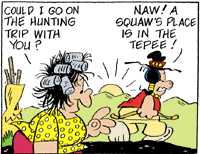Response from Editor of "Belle" magazine
We appreciate your feedback this week and apologize for any offense the story and images may have caused you.
You may find the post online here, and below.
Best,
Jason Roop
Editor in Chief
To the Reader
Style received several e-mails from people who took offense to a story in the November issue of Belle, our monthly magazine for Richmond women. In it we featured local artist and animal-rights activist Kate Horne, who often wears a Native American headdress during the First Fridays Art Walk.
Those offended expressed anger that we would picture Horne in the headdress, saying that it was demeaning to what is a sacred symbol for many, and disrespectful to Native Americans. Some writers also expressed anger at the use of the word “squaw,” which in our context meant “young woman,” but is a sore subject for many who see more controversial meanings represented by the word. (There is ongoing debate about the word’s historical allusions.)
We write about various cultural issues on a regular basis and always intend to treat such subjects with respect. We apologize to these letter-writers and any other readers who were offended by the story and photos. We will take the concerns you’ve expressed with us into account as we prepare content for future issues.
In addition, Metro Space Gallery, where the artist works, has issued an invitation to Native American artists to submit their work for consideration in a Native American art exhibit, of which proceeds would be donated to an approved Native American charity. Contact Mark Szafranski at events@metrospacegallery.com.
The Editors
Figured it was a step in the right direction and a little healing couldn't hurt!
I'd say "tepid" aptly describes this non-apology apology. Let's parse it:
One, she's stereotyping Indians as primitive people of the past. She's implying that all Indians are Plains Indians.
Two, she's dressing up in the Native equivalent of blackface. To Natives, this isn't any more acceptable than putting shoe polish on her face and pretending to be a plantation's Big Mammy. Yet Belle endorsed every aspect of this minstrel-like display with its uncritical article and photos.
squaw
2. Slang: Disparaging and Offensive.
a. a wife.
b. any woman or girl.
Whether "squaw" has a negative origin or not, it's an outdated racial label. It's like calling every Native man a "brave" and every Native baby a "papoose." You wouldn't think of calling a modern Native man a "brave," so why would you call a (faux) Native women a "squaw"?
In other words, it's equivalent at best to calling a woman a Negress or Jewess. Again, the parallels to "mammy" is apt, which is why I used it. A big-hearted mammy laughs and a stoic squaw doesn't, but they both represent women as second-class citizens.
"Squaw" explained to Belle
No need to take my word for it. Here's what critics have said about "squaw":
You paleface; me male fantasy
In Terrence Malick's new film, Hollywood panders to old prejudices about Native American women
By Kevin Maher
The art gallery offer
The art gallery's offer of a Native show is as good as far as it goes. Especially since the gallery is at fault for hosting Horne and her "Big Squaw" minstrel show.
But note: The gallery hasn't guaranteed the show will go on. There's a chance it'll deem the Native submissions unacceptable or "forget" about the show after the controversy dies down. Better would be to hold a Native show now--by finding one in the Virginia area. And to accept artists' submissions for a charitable show down the line.
Also better would be to inform us that the Big Squaw minstrel show is ending. That Horne has apologized and will make amends somehow. Or that the gallery has expelled her for not abandoning her racist take on Indians.
And the gallery is only part of the problem. What is Belle magazine doing to make up for promoting Native stereotypes to thousands of readers? Other than issuing this tepid apology, that is?
For more on the subject, see see Squelching the S-Word and Why Hipster Headdresses Aren't Okay.
Below: A typical squaw as unattractive, servile, and second-class.


No comments:
Post a Comment